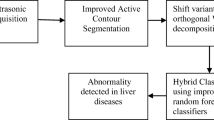Abstract
Recent advances in digital imaging technology have greatly enhanced the interpretation of critical/pathology conditions from the 2-dimensional medical images. This has become realistic due to the existence of the computer aided diagnostic tool. A computer aided diagnostic (CAD) tool generally possesses components like preprocessing, identification/selection of region of interest, extraction of typical features and finally an efficient classification system. This paper enumerates on development of CAD tool for classification of chronic liver disease through the 2-D image acquired from ultrasonic device. Characterization of tissue through qualitative treatment leads to the detection of abnormality which is not viable through qualitative visual inspection by the radiologist. Common liver diseases are the indicators of changes in tissue elasticity. One can show the detection of normal, fatty or malignant condition based on the application of CAD tool thereby, further investigation required by radiologist can be avoided. The proposed work involves an optimal block analysis (64 × 64) of the liver image of actual size 256 × 256 by incorporating Gabor wavelet transform which does the texture classification through automated mode. Statistical features such as gray level mean as well as variance values are estimated after this preprocessing mode. A non-linear back propagation neural network (BPNN) is applied for classifying the normal (vs) fatty and normal (vs) malignant liver which yields a classification accuracy of 96.8%. Further multi classification is also performed and a classification accuracy of 94% is obtained. It can be concluded that the proposed CAD can be used as an expert system to aid the automated diagnosis of liver diseases.








Similar content being viewed by others
Explore related subjects
Discover the latest articles and news from researchers in related subjects, suggested using machine learning.References
Raufaste, E., and Eyrolle, H., Expertise et diagnostic radiologique. I.Avancées théoriques. J. Radiol. 79:227–234, 1998.
Cauvin, J. M., Guillou, C. L., Solaiman, B., Robaszkiewicz, M., Beux, P. L., and Roux, C., Computer-assisted diagnosis system in digestive endoscopy. IEEE Trans. Inf. Technol. Biomed. 7:4256–262, 2003. doi:10.1109/TITB.2003.823293.
Mendler, M.-H., et al., Dual-energy CT in the diagnosis and quantification of fatty liver: limited Clinical Value in Comparison to ultrasound scan and single-energy CT, with special reference to iron overload. J. Hepatol. 28:785–794, 1998. doi:10.1016/S0168-8278(98)80228-6.
Chung-Ming, W., Yung-Chang, C., and Kai-Sheng, H., Texture features for classification of ultrasonic liver images. IEEE Trans. Med. Imaging. 11:3141–152, 1992.
Unser, M., Texture classification and segmentation using wavelet frames. IEEE Trans. Image Process. 4:1549–1569, 1995. doi:10.1109/83.469936.
Mougiakakou, G., Valavanis, I., Nikita, K. S., Nikita, A., and Kelekis, D., Characterization of CT liver lesions based on texture features and a multiple neural network classification scheme. Proc. IEEE EMBC 1287–1290, 2003.
Manjunath, B. S., and Ma, W. Y., Texture Features for Browsing and Retrieval of Image Data. IEEE Trans. Pattern Anal. Mach. Intell. 18:8837–842, 1996. doi:10.1109/34.531803.
Ahmadian, A., Mustafa, An efficient texture classification algorithm using Gabor Wavelet, Proc. of the 25th Annual International Conference of the IEEE EMBS Cancunz, Mexico-September 17–21, 2003.
Kyriacou, E., S. Pavlopoulos, G., Konnis, D., Koutsouris P., and Zounipoulis, I., Theotokai, Computer assisted characterization of diffused liver disease using image texture analysis techniques on B-Scan images, Proceedings of IEEE, 1479–1483.
Poonguzhali, S., and Ravindran, G., Performance evaluation of feature extraction methods for classifying liver abnormalities in ultrasound images using Neural network, Proc. Of the 28th Annual International Conference of the IEEE EMBS, New York, 4791–4794, 2006.
Abou zaid Sayed Abou zaid, Mohamed Waleed Fakhr, Ahmed Farag Ali Mohamed Automatic diagnosis of liver diseases from ultrasound images, Proceedings of IEEE 2006, 313–319.
Poonguzhali, S., Deepalakshmi, B., and Ravindran, G., Optimal features and selection and automatic classification of abnormal masses in ultrasound liver images, Proc. Of the IEEE-ICSN 2007, 503–506, 2007
Lee, T. S., Image representation using 2D Gabor wavelets. IEEE Trans. Pattern Anal. Mach. Intell. 18:10959–971, 1996.
Dony, D., and Haykin, S., Neural network approaches to image compression. Proc. IEEE. 83:288–303, 1995. doi:10.1109/5.364461.
Haykin, S., Neural Networks—a comprehensive study, 2nd ed, Pearson's Education Inc., 2001.
Demuth, H., and Beale, M., Neural network toolbox for use with MATLAB, Mathsworks, (1998).
Author information
Authors and Affiliations
Corresponding author
Rights and permissions
About this article
Cite this article
Sriraam, N., Roopa, J., Saranya, M. et al. Performance Evaluation of Computer Aided Diagnostic Tool (CAD) for Detection of Ultrasonic Based Liver Disease. J Med Syst 33, 267–274 (2009). https://doi.org/10.1007/s10916-008-9187-z
Received:
Accepted:
Published:
Issue Date:
DOI: https://doi.org/10.1007/s10916-008-9187-z




